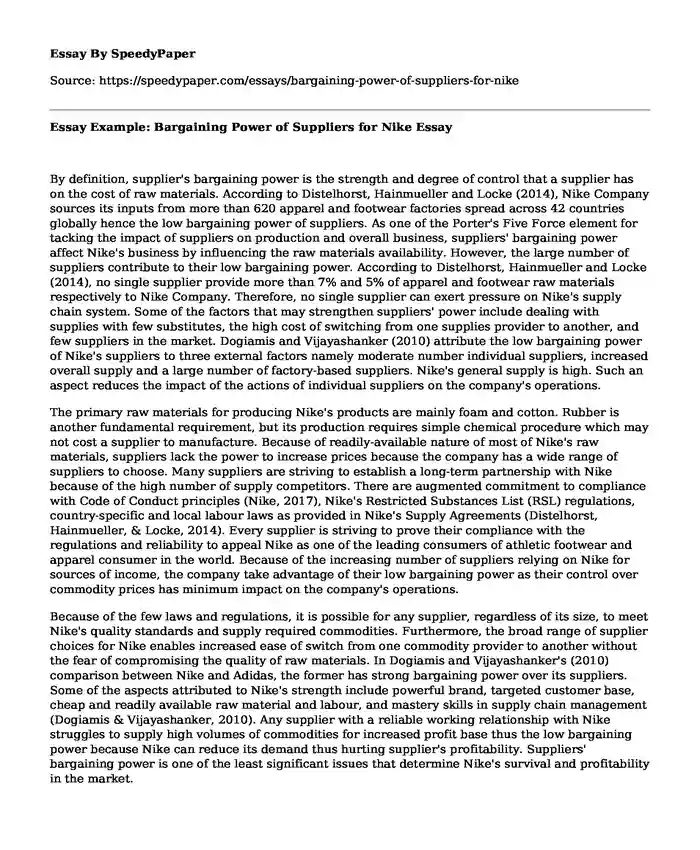
| Type of paper: | Essay |
| Categories: | Business Nike Supply chain management |
| Pages: | 3 |
| Wordcount: | 611 words |
By definition, supplier's bargaining power is the strength and degree of control that a supplier has on the cost of raw materials. According to Distelhorst, Hainmueller and Locke (2014), Nike Company sources its inputs from more than 620 apparel and footwear factories spread across 42 countries globally hence the low bargaining power of suppliers. As one of the Porter's Five Force element for tacking the impact of suppliers on production and overall business, suppliers' bargaining power affect Nike's business by influencing the raw materials availability. However, the large number of suppliers contribute to their low bargaining power. According to Distelhorst, Hainmueller and Locke (2014), no single supplier provide more than 7% and 5% of apparel and footwear raw materials respectively to Nike Company. Therefore, no single supplier can exert pressure on Nike's supply chain system. Some of the factors that may strengthen suppliers' power include dealing with supplies with few substitutes, the high cost of switching from one supplies provider to another, and few suppliers in the market. Dogiamis and Vijayashanker (2010) attribute the low bargaining power of Nike's suppliers to three external factors namely moderate number individual suppliers, increased overall supply and a large number of factory-based suppliers. Nike's general supply is high. Such an aspect reduces the impact of the actions of individual suppliers on the company's operations.
The primary raw materials for producing Nike's products are mainly foam and cotton. Rubber is another fundamental requirement, but its production requires simple chemical procedure which may not cost a supplier to manufacture. Because of readily-available nature of most of Nike's raw materials, suppliers lack the power to increase prices because the company has a wide range of suppliers to choose. Many suppliers are striving to establish a long-term partnership with Nike because of the high number of supply competitors. There are augmented commitment to compliance with Code of Conduct principles (Nike, 2017), Nike's Restricted Substances List (RSL) regulations, country-specific and local labour laws as provided in Nike's Supply Agreements (Distelhorst, Hainmueller, & Locke, 2014). Every supplier is striving to prove their compliance with the regulations and reliability to appeal Nike as one of the leading consumers of athletic footwear and apparel consumer in the world. Because of the increasing number of suppliers relying on Nike for sources of income, the company take advantage of their low bargaining power as their control over commodity prices has minimum impact on the company's operations.
Because of the few laws and regulations, it is possible for any supplier, regardless of its size, to meet Nike's quality standards and supply required commodities. Furthermore, the broad range of supplier choices for Nike enables increased ease of switch from one commodity provider to another without the fear of compromising the quality of raw materials. In Dogiamis and Vijayashanker's (2010) comparison between Nike and Adidas, the former has strong bargaining power over its suppliers. Some of the aspects attributed to Nike's strength include powerful brand, targeted customer base, cheap and readily available raw material and labour, and mastery skills in supply chain management (Dogiamis & Vijayashanker, 2010). Any supplier with a reliable working relationship with Nike struggles to supply high volumes of commodities for increased profit base thus the low bargaining power because Nike can reduce its demand thus hurting supplier's profitability. Suppliers' bargaining power is one of the least significant issues that determine Nike's survival and profitability in the market.
References
Distelhorst, G., Hainmueller, J., & Locke, R. (2014). Does Lean Improve Labor Standards? Capability Building and Social Performance in the Nike Supply Chain. Toronto: University of Toronto.
Dogiamis, G., & Vijayashanker, N. (2010). Adidas: Sprinting Ahead of Nike. Santa Clara: McAfee.
Nike. (2017). Doing Business with NIKE, Inc.- About Nike. Retrieved from Nike: https://about.nike.com/pages/doing-business-with-nike
Cite this page
Essay Example: Bargaining Power of Suppliers for Nike. (2022, Mar 02). Retrieved from https://speedypaper.net/essays/bargaining-power-of-suppliers-for-nike
Request Removal
If you are the original author of this essay and no longer wish to have it published on the SpeedyPaper website, please click below to request its removal:
- Borderline Personality Disorder Essay Sample
- Naturalistic Observation - Essay Sample on Eye Contact
- Sport Essay Example: Cricket Versus Baseball
- Research Paper Sample on Teleworking
- Essay Example on Three Major Elements of US History
- Paper Example. Urban Education and Related Trends
- Free Essay on Political and Social Causes of School Shootings (Sandy Hook)
Popular categories




